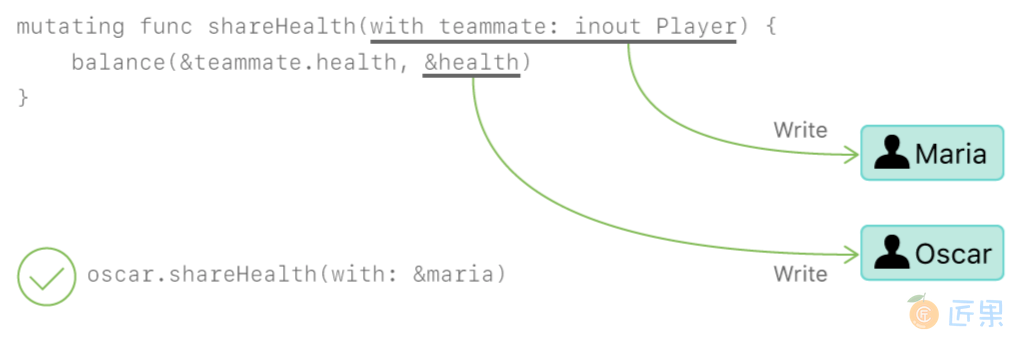一个结构体的 mutating 方法会在调用期间对 self 进行写访问。例如,想象一下这么一个游戏,每一个玩家都有血量,受攻击时血量会下降,并且有敌人的数量,使用特殊技能时会减少敌人数量。
struct Player {
var name: String
var health: Int
var energy: Int
static let maxHealth = 10
mutating func restoreHealth() {
health = Player.maxHealth
}
}
在上面的 restoreHealth() 方法里,一个对于 self 的写访问会从方法开始直到方法 return。在这种情况下,restoreHealth() 里的其它代码不可以对 Player 实例的属性发起重叠的访问。下面的 shareHealth(with:) 方法接受另一个 Player 的实例作为 in-out 参数,产生了访问重叠的可能性。
extension Player {
mutating func shareHealth(with teammate: inout Player) {
balance(&teammate.health, &health)
}
}
var oscar = Player(name: "Oscar", health: 10, energy: 10)
var maria = Player(name: "Maria", health: 5, energy: 10)
oscar.shareHealth(with: &maria) // 正常
上面的例子里,调用 shareHealth(with:) 方法去把 oscar 玩家的血量分享给 maria 玩家并不会造成冲突。在方法调用期间会对 oscar 发起写访问,因为在 mutating 方法里 self 就是 oscar,同时对于 maria 也会发起写访问,因为 maria 作为 in-out 参数传入。过程如下,它们会访问内存的不同位置。即使两个写访问重叠了,它们也不会冲突。
当然,如果你将 oscar 作为参数传入 shareHealth(with:) 里,就会产生冲突:
oscar.shareHealth(with: &oscar)
// 错误:oscar 访问冲突
mutating 方法在调用期间需要对 self 发起写访问,而同时 in-out 参数也需要写访问。在方法里,self 和 teammate 都指向了同一个存储地址——就像下面展示的那样。对于同一块内存同时进行两个写访问,并且它们重叠了,就此产生了冲突。

